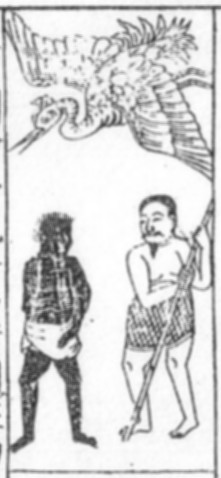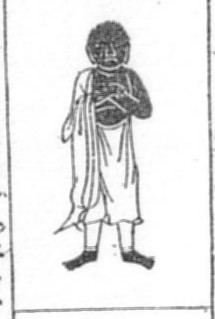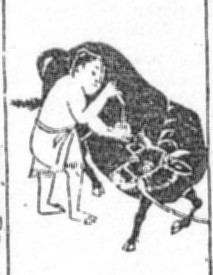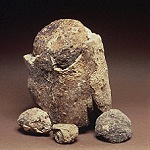


Chao Ju-Kua (1226) he was commissioner in foreign trade
Chu-fan-chih or Zhufan zhi ( Description of barbarous people)
-----------------------------------------------------
Text taken from: -Freeman Grenville; Selected Documents
-James de Verre Allen; Swahili Origin
-Basil Davidson; The lost cities of Africa
-Teobaldo Filesi; China and Africa in the Middle Ages
-Duyvendak; China's Discovery of Africa
-Hirth and Rockhill : Chao, Ju-Kua
also called Zhao Rugua
The products of the country (of the ta-shi) consists in pearls, ivory, rhinoceros horns, frankincense, ambergris, putchuck, cloves, nutmegs, benzoin (an-si hiang), aloes, myrrh, dragon's-blood, asa-foetida, wu-na-ts'i, borax, opaque and transparent glass, ch'o-k'u shell, coral, cat's-eyes, gardenia flowers, rose-water, nut galls, yellow wax, soft gold brocades , camel's hair cloth, tou-lo cottonades and foreign satins.
The foreign traders who deal in these merchandise, bring them to San-fo-ts'i and Fo-lo-an to barter.
The following countries are dependencies of this country:
Ma-lo-mo (Mirbat) Na-fu (Zufar now Dhofar)
Shi-ho (Shehr) Ya-ssi-pau-hien (Ispahan)
Lo-ssi-mei (Khwarizm) P'u-hua-lo (Bokhara)
Mu-ku-lan (Makran) Ts'ong-pa (Zanzibar)
K'ie-li-ki (Kalhat) Pi-p'a-lo (Berbera)
P'i-no-ye (Ifrikya) Wu-pa (Sohar)
I-lu (Irak) Wong-li (Oman)
Pai-ta (Baghdad) Ki-shi (Kish)
Ssi-lien (Siraf) Ma-kia (Mecca)
Pai-lien (Bahrein) Pi-ssi-lo (Basra)
Tsi-ki (Tiz) Ki-tz'i-ni (Ghazni)
Kau-mei (Comore ) Wu-ssi-li (Mosul or Misr)
In the fourth year of the shun-hua period (993) they (the Persians) sent tribute through the assistant envoy Li-a-wu who stated, at an audience granted him in the Ch'ung-chong Audience Hall, that this country bordered on Ta-ts'in, and that it produces ivory and rhinoceros horns. The emperor T'ai-tsung asked him how rhinoceros and elephants were hunted.....
Note: This ivory and rhino horn Persia acquired through the port of Siraf from East Africa. More information about this visit is found in the Sung-Shi.
Under "Countries situated in the sea " is mentioned the country of Kan-mei (which might be the Comoro islands).
ZANGUEBAR (TS'ONG-PA)
Note: Tsong-ba or Tsang-Bat or Zengba in Cantonese is literally Zang-bar
The Ts'ong-pa country is an island of the sea south of Hu-ch'a-la (Guzerat). To the west it reaches a great mountain. The inhabitants are of Ta-shi (Arab) stock and follow the Ta-shi religion. They wrap themselves in blue foreign cotton stuffs and wear red leather shoes. Their daily food consists of meal, shaobing (baked cakes) and mutton.
There are many villages, and a succession of wooded hills and terraced rocks. The climate is warm, and there is no cold season. The products of the country consist of elephants' tusks, un-worked gold, ambergris and yellow sandal (or fragrant)-wood. (t'an hsiang) Every year Hu-ch'a-la (the Indian kingdom of Gujerat) and the Ta-shi (Arab) localities along the sea coast send ships to this country with white cotton cloth, porcelain, copper, and red cotton to trade.
Note: The true sandalwood tree does only grow in East Asia. So here we must have a variety that resembles it.
BERBERA COAST (PI-P'A-LO) (OR BI-BA-LUO)
The country of Pi-p'a-lo contains four cities, (these are Mogadishu, Merca, Barawa, and the settlement near the mouth of the Juba which has long been abandoned) the other places are all villages which are constantly at feud and fighting with each other. The inhabitants pray to Heaven and not to the Buddha. The land produces many camels and mien-yang (sheep), and the people feed themselves with the flesh and milk of camels and with baked cakes.
The other products are ambergris, big elephants' tusks and big rhinoceros' horns. There are elephants' tusks with weigh over 100 catties and rhinoceros' horns of over ten catties weight. The land is also rich in mu-hsiang (putchuk), liquid storax gum, myrrh, and tortoise-shell of extra-ordinary thickness, for which there is great demand in other countries. The country also brings forth the so called "camel-crane" (ostrich) called by the Persians ushtumurgh and by the Arabs tayr al-jamal. which measures from the ground to its crown from six to seven feet. It has wings and can fly, but not to any great height.
There is also in this country a wild animal called tsu-la (giraffe), it resembles a camel in shape, an ox in size, and is of yellow color. Its fore legs are five feet long, its hind legs only three feet. Its head is high up and turned upwards. Its skin is an inch thick.
There is also in this country a kind of mule (zebra) with brown, white, and black stripes around its body. These animals wander about the mountain wilds, they are a variety of the camel. The inhabitants of this country, who are great huntsmen, hunt these animals with poisoned arrows.
THE LAND BORDERING BERBERA (TIUNG-LJI)also called Zhonglji or Chung-li
Note: For long it was thought that the land of Tiung-Lji was in Arabia, till one found that the translation of the name comes close to Shangaya, Jungaya...making it a candidate for Shungwaya.
The inhabitants of the country of Chung-li go bareheaded and barefoot. They wrap a cloth around themselves but do not wear jackets. Only ministers and the king's courtiers wear jackets and turbans as a mark of distinction. The king's residence is masoned out of large bricks and slabs of stone; the people's houses are made of palm leaves and are covered with thatch. Their daily fare consists of baked flour-cakes, sheep's and cattle's milk. Cattle, sheep and camels are their big food (only eaten at special occasions)...
Among the countries of the Ta-shi (Arabs) this is the only one which produces frankincense.
Its people are given to magical tricks, changing themselves into birds, beasts and aquatic animals so as to "bewilder ignorant people", or prevent ships of foreign merchants from moving either forwards or backwards until their captains have settled outstanding disputes. The government has formally forbidden this practice.
Every year migrating birds alight in the open country in countless numbers. At sunrise they suddenly disappear, leaving no trace. The inhabitants trap and eat large numbers of them which alight outside the suburbs for they are of excellent taste. They are available till the end of spring but depart with the unset of summer, only to reappear in the following year.
When a man dies his kinsmen gather from far and wide. They brandish their weapons and ask the chief mourner to disclose the cause of death. If he was murdered, they say, we shall kill the murderer in revenge with these swords. But if the chief mourner replies that no one killed him and it was a natural consequence of Heaven's decree, they throw down their swords and weep bitterly.
A huge fish up to 200 ch'ch (1ch'ch=36cm) in length and 20 ch'ch high, is stranded each year on the coast of Tiung-lji the local folk cut out the marrow, brains, eyes, to get oil, a single animal sometimes yielding more then 300 teng (jars). Which is used for lamps or mixed with lime to caulk boats, through the flesh is not eaten. Poor people use the ribs of whales as rafters, and their backbones as doors, while they cut of their vertebrae and use them as mortars.
The country has a shan (hills or mountains) which are contiguous with Pi-pa-lo (Berbera). The boundaries of the land are about 4,000 li long. (1,664 km) Through most of it is unpopulated. The mountains produce dragon's blood (a red gum resin of the shrub Dracaena) and aloes, and the waters (of the sea) produce tortoise- shell and ambergris. It is not known where the ambergris comes from, suddenly it appears in lumps, sometimes 3-5, sometimes 10 catties in weight, (one catty = 750 gr) driven on the shore by the wind. The natives vie with one another in dividing it. Sometimes a ship at sea runs across it and picks it up.
MADAGASCAR (K'UN LUN-TS'ONG-K'I) (or K'un-lun-ts'eng-ch'i)
This island is in the south west. It is adjacent to a large island. There are usually there great p'ong birds which so mask the sun in their flight that the shade on the sundial is shifted. If the great p'ong bird (rukh) finds a wild camel it swallows it, and if one should chance to find a p'ong's feather, he can make a water-butt of it, after cutting off the hollow quill. ( to use them as buckets at both ends of a shoulder-pole)
The products of the country are big elephants' tusks, and rhinoceros horns. In the west there is an island in the sea on which there are many savages, with bodies as black as lacquer and with frizzled hair. They are enticed by food, then caught and carried off for slaves to the Ta'shi countries where they fetch a high price. They are used as gate keepers. It is said that they do not long for their kinfolk
Note ; I found also another translation of this description of the giraffe: It had a leopard's hide, a cow's hoofs, a ten food-tall body, and a nine-food neck towering above that. It was called a zula (from arabic zurafa from giraffe)
Chao Ju-Kua also relates that in China for a boy three taels of gold were paid, or the equivalent in scented wood, and that the slaves were also used on ships to repair leaks underwater. (a tael is 580 gr of silver, as well as 1000 ch'ien this is coins with a square hole in the middle)
Chao Ju Kua later on in his book also gives a list of the main commodities imported in China. Nowhere is mentioned they come from Africa. Every time the (Muslim) harbor from where the shipping took place is mentioned.
Myrrh
Mo-yau comes from the country of Mo-lo-mo (Merbat) of the Ta-shi. The tree resembles in height and size the pine-tree of China; its bark is one or two inches thick. At the times of gathering the incense they first dig a hole in the ground at the foot of the tree, and then split open the bark with a hatchet, upon which the juice runs down into the hole during fully ten days, when it is removed.
Dragon�s blood
Hue-kie comes also from the Ta-shi countries. The tree is somewhat like the myrrh-tree, except that it leaves are rather different in size from those of the latter; the manner of gathering is also the same. There is a variety of tree which is as smooth as the face of a mirror; these are old trees, their juice flows spontaneously, without their being tapped by the hatchet; this is the best quality. Incense which contains an admixture of bits of wood is made of the juice of the lakawood-tree, and is commonly called: imitation dragon�s blood.
Liquid storax
Su-ho-hiang-yu comes from the countries of t he Ta-shi. Its aroma and taste are, on the whole, similar to those of tu-nau (dammar). Richness and freedom from sediment are the first requisites in a good sample.
Foreigners commonly use it to rub their bodies with, and the natives of Fu-kien use it in like fashion when afflicted with paralysis. It is mixed with juan-hiang (incenses of delicate aroma), and may be used in medicine.
Putchuck
Mu-hiang comes from the country of Mo-lo-mo (Merbat) of the Ta-shi; it is also found in Shi-ho (Shehr) and Nu-fa (Zufar now Dhofar). The plant resembles the Chinese ssi-kua. The winter months is the time of gathering the root, which is chopped into pieces of one or two inches in length and sun-dried. Pieces like a chicken bone are of the best quality.
Ivory
Siang-ya, or ivory, comes from several countries of the Ta-shi and the two countries of Chou-la and Chan-chong. The Ta-shi product is the better, and that of Chou-la and Chan-chong is inferior. Among the Ta-shi countries it is only at Ma-lo-pa that one finds any large supply.
The elephant lives in the depths of the hills and the remotest valleys, but every now and then he comes out of the wild into the plains and tramples down everything, so that man is afraid to come near him.
Elephant hunters make use of bows of extraordinary strength and poisoned arrows. When hit by an arrow the elephant runs away, but before he has gone a li or two, or a little more, the arrow poison acts and the animal falls down dead. The hunters follow him, remove the tusks from the carcass and bury them in the ground. When ten tusks or more have been collected, they are brought to the Ta-shi, who ship them to San-fo-tsi and Ji-lo-ting for barter.
Large specimens weigh from fifty to an hundred catties. The tusks which are straight and of a clear white color and which show a pattern of delicate streaks come from the Ta-shi; whereas the produce of Chou-la and Chan-chong consists of small tusks of a reddish tint, weighing only from 10 to 20 or 30 catties, and of tips of tusks, which can only be made into scent holders. Some people say that elephants are caught by decoys, and I presume that the tame elephant is used for that purpose.
Rhinoceros Horns
The si, or rhinoceros, resembles the domestic cattle, but it has only one horn. Its skin is black and its hair scanty; its tongue is like the burr of a chestnut. Fierce and violent in its temper, this animal runs so quickly that you may imagine it is flying. Its food consists solely of bamboo and other woods. Since he rips up a man with his horn, none dare come near him, but hunters shoot him with a stiff arrow from a good distance, after which they remove the horn, which in this state is called a fresh horn whereas, if the animal has died a natural death the horn obtained from it is called a dropped-in-the-hills horn. The horn bears marks like bubbles; the horns which are more white than black are the best.
Castoreum, Civet
(The drug called) wu-na-tsi comes from the country of Kie-li-ki (Kalhat?) of the Arabs. (The animal called wu-na) resembles in shape a hua. Its legs are as long as those of a dog; its color is either red or black. It moves as it were flying. Hunters stretch nets near the sea-shore to catch it. What is taken from its scrotum and mixed with oil is called wu-na-tsi. Po-ni (Borneo) is the only foreign country in which it is very abundant.
Ambergris
In the Western Sea of the Ta-shi there are dragons in great number. Now, when a dragon (lung) in lying on a rock asleep, his spittle (hien) floats on the water, collects and turns hard, and the fishermen gather it as a most valuable substance. Fresh ambergris is white in color, when slightly stale it turns red, and black when it is quite old. It is neither fragrant nor bad-smelling, it is like pumice-stone, but lighter. The statement that a special perfume is derived from ambergris, and the other statement to the effect that the odor of ambergris can bring out all other scents, are both erroneous.
Ambergris does not affect the properties of perfumes in any way, either by improving or by spoiling them; ir merely has the power of keeping the fumes together. When a quantity of genuine ambergris is mixed with incense, and is being burned, a straight column of clear blue smoke rises high up into the air, and the smoke will note dissipate, and those present could cut the column of smoke with a pair of scissors. This is occasioned by the virtue left in the ambergris by which the dragon exhales cloud-borne buildings.
-------------------------------------------------------------------------------------------------------------------
Some explanations on these commodities as found in :
Taken from: Wheatley, Paul 1959 Geographical Notes on some Commodities involved in Sung Maritime Trade
(Wu-na ch�i) Civet
Here the civet of several animals is meant:
1 Civet from Ch�ieh-li-chi, = Kalhat, on the coast of Oman Any civet from the coast of Oman must almost certainly have been true civet of the African civet, Viverra civetta.
2 They could have obtained of nearly the same quality in India, procured from the Indian civet, V. zibetha.
3 When he writes P'o-ni [Brunai] is the only foreign country in which it is very abundant the Malay civet, V. tangalunga, which produces a secretion of about the same quality.
4 He also reports that an animal yielding civet was trapped in nets off-shore; the seal of the North Pacific.
(So-ho hsiang-yu) Liquid storax.
Or sweet oil of storax was a product from the Berbera coast, Baghdad Ghazni and Asia Minor. It was obtained by subjecting the bark of Liquidambar orientalis to heat and compression. This liquid storax has been confused with the storax of antiquity which came from the bark of the Styrax officinalis a Mediterranean shrub.
Ambergris:
A product from the Zanzibar Berbera and Somali coast. All authors agree that the Chinese never knew that it could also be found on the shores of China, Japan etc�
